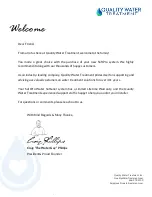
31
Burner operatIon and InspectIon
Flood damage to a water heater may not be readily visible or immediately
detectable. However, over a period of time a flooded water heater will
create dangerous conditions which can cause DEATH, SERIOUS
BODILY INJURY, OR PROPERTY DAMAGE. Contact a qualified installer
or service agency to replace a flooded water heater. Do not attempt to
repair the unit! It must be replaced!
At least once a year a visual inspection should be made of the main burner
and the hot surface igniter assembly for proper flame characteristics
and ignition sequences. This can be done by removing the Outer Door
and viewing the main burner operation through the Viewport on the
Inner Door, see Figure 1. The main burner should provide complete
combustion of gas, ignite rapidly, give reasonably quiet operation, and
cause no excessive flame lifting from the burner ports. If the proper flame
characteristics are not evident (see Figure 27), make sure that the flow
of combustion and ventilation air is not blocked.
You should also check for sooting. Soot is not normal and will impair proper
combustion. A visual inspection of the main burner and HSI should
also be done at least once a year, see Figure 27.
Soot build-up indicates a problem that requires correction before
further use. Turn “OFF” gas to water heater and leave off until repairs
are made, because failure to correct the cause of the sooting can result
in a fire causing death, serious injury, or property damage.
fIGure 27.
Burner cleanInG
In the event your burner or burner air openings require cleaning, turn
the blower switch to the “OFF” position and allow the burner to cool.
Call a service agency to remove and clean the burner and correct the
problem that required the burner to be cleaned.
houseKeepInG
Vacuum around base of water heater for dust, dirt, and lint on a
regular basis.
INSTALLED IN SUITABLE AREA: To insure sufficient ventilation
and combustion air supply, proper clearances from the water heater
must be maintained. See “Locating the New Water Heater” section.
Combustible materials such as clothing, cleaning materials, or
flammable liquids, etc. must not be placed against or adjacent to the
water heater which can cause a fire.
anode rod InspectIon
Each water heater contains at least one anode rod, which will slowly
deplete (due to electrolysis) prolonging the life of the water heater by
protecting the glass-lined tank from corrosion. Adverse water quality,
hotter water temperatures, high hot water usage, and water softening
methods can increase the rate of anode rod depletion. Once the anode rod
is depleted, the tank will start to corrode, eventually developing a leak.
Certain water conditions will cause a reaction between the anode rod
and the water. The most common complaint associated with the anode
rod is a “rotten egg smell” produced from the presence of hydrogen
sulfide gas dissolved in the water. IMPORTANT: Do not remove this
rod permanently as it will void any warranties. The parts list includes a
special anode rod that can be ordered if water odor or discoloration occurs.
NOTE: This rod may reduce but not eliminate water odor problems. The
water supply system may require special filtration equipment from a water
conditioning company to successfully eliminate all water odor problems.
Artificially softened water is exceedingly corrosive because the process
substitutes sodium ions for magnesium and calcium ions. The use of
a water softener may decrease the life of the water heater tank.
The anode rod should be removed from the water heater tank every
3 years for inspection. NOTE: artificially softened water requires the
anode rod to be inspected annually.
The following are typical (but not all) signs of a depleted anode rod:
* The majority of the rods diameter is less than 3/8”.
* Significant sections of the support wire (approx. 1/3 or more of the
anode rod’s length) are visible.
If the anode rod show signs of either or both it should be replaced.
NOTE: Whether re-installing or replacing the anode rod, check for
any leaks and immediately correct if found.
In replacing the anode:
1. Turn off gas supply to the water heater.
2. Shut off the water supply and open a nearby hot water faucet to
depressurize the water tank.
3. Drain approximately 5 gallons of water from tank (Refer to “Draining
and Flushing” for proper procedures). Close drain valve.
4. Remove old anode rod.
5. Use Teflon® tape or approved pipe sealant on threads and install
new anode rod.
6. Turn on water supply and open nearby hot water faucet to purge air
from water system. Check for any leaks and immediately correct
any if found.
Restart the water heater as directed under “Operating Your Water Heater.”
See the Repair Parts Illustration for anode rod location.
fIGure 28. anode rod depletIon.
Содержание vG6250t76nv
Страница 3: ...3 GENERAL SAFETY INFORMATION ...
Страница 8: ...8 TYPICAL INSTALLATION CONDENSATE HOSE AND DRAIN PAN FIGURE 1A ...
Страница 28: ...28 ...
Страница 38: ...38 TROUBLESHOOTING GUIDELINES NOTES ...










































